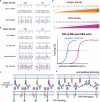Universal CAR 2.0 to overcome current limitations in CAR therapy
- PMID: 38962014
- PMCID: PMC11219820
- DOI: 10.3389/fimmu.2024.1383894
Universal CAR 2.0 to overcome current limitations in CAR therapy
Abstract
Chimeric antigen receptor (CAR) T cell therapy has effectively complemented the treatment of advanced relapsed and refractory hematological cancers. The remarkable achievements of CD19- and BCMA-CAR T therapies have raised high expectations within the fields of hematology and oncology. These groundbreaking successes are propelling a collective aspiration to extend the reach of CAR therapies beyond B-lineage malignancies. Advanced CAR technologies have created a momentum to surmount the limitations of conventional CAR concepts. Most importantly, innovations that enable combinatorial targeting to address target antigen heterogeneity, using versatile adapter CAR concepts in conjunction with recent transformative next-generation CAR design, offer the promise to overcome both the bottleneck associated with CAR manufacturing and patient-individualized treatment regimens. In this comprehensive review, we delineate the fundamental prerequisites, navigate through pivotal challenges, and elucidate strategic approaches, all aimed at paving the way for the future establishment of multitargeted immunotherapies using universal CAR technologies.
Keywords: CAR (chimeric antigen receptor) T-cell therapy; antibody therapies; cancer immune cell therapy; iPSC (induced pluripotent stem cell); individualized cancer therapy.
Copyright © 2024 Schlegel, Werbrouck, Boettcher and Schlegel.
Conflict of interest statement
PS and CW are inventors of patents in the field of indirect CAR technologies. The remaining authors declare that the research was conducted in the absence of any commercial or financial relationships that could be construed as a potential conflict of interest.
Figures




Similar articles
-
Risks and Benefits of Chimeric Antigen Receptor T-Cell (CAR-T) Therapy in Cancer: A Systematic Review and Meta-Analysis.Transfus Med Rev. 2019 Apr;33(2):98-110. doi: 10.1016/j.tmrv.2019.01.005. Epub 2019 Feb 14. Transfus Med Rev. 2019. PMID: 30948292
-
Chimeric Antigen Receptor T Cell Exhaustion during Treatment for Hematological Malignancies.Biomed Res Int. 2020 Oct 23;2020:8765028. doi: 10.1155/2020/8765028. eCollection 2020. Biomed Res Int. 2020. PMID: 33150182 Free PMC article. Review.
-
Immune Cell Hacking: Challenges and Clinical Approaches to Create Smarter Generations of Chimeric Antigen Receptor T Cells.Front Immunol. 2018 Jul 31;9:1717. doi: 10.3389/fimmu.2018.01717. eCollection 2018. Front Immunol. 2018. PMID: 30108584 Free PMC article. Review.
-
Advances in CAR T cell therapy: antigen selection, modifications, and current trials for solid tumors.Front Immunol. 2025 Jan 6;15:1489827. doi: 10.3389/fimmu.2024.1489827. eCollection 2024. Front Immunol. 2025. PMID: 39835140 Free PMC article. Review.
-
CAR T-Cell Therapy in Hematologic Malignancies: A Voyage in Progress.Clin Pharmacol Ther. 2020 Jan;107(1):112-122. doi: 10.1002/cpt.1674. Epub 2019 Nov 25. Clin Pharmacol Ther. 2020. PMID: 31622496 Review.
Cited by
-
CAR-T cell therapy clinical trials: global progress, challenges, and future directions from ClinicalTrials.gov insights.Front Immunol. 2025 May 20;16:1583116. doi: 10.3389/fimmu.2025.1583116. eCollection 2025. Front Immunol. 2025. PMID: 40463393 Free PMC article. Review.
-
CliniMACS Prodigy Manufacturing of Switchable, AND-Gate CAR T Cells.Int J Mol Sci. 2025 May 23;26(11):5024. doi: 10.3390/ijms26115024. Int J Mol Sci. 2025. PMID: 40507834 Free PMC article.
-
Logic-gated and contextual control of immunotherapy for solid tumors: contrasting multi-specific T cell engagers and CAR-T cell therapies.Front Immunol. 2024 Nov 13;15:1490911. doi: 10.3389/fimmu.2024.1490911. eCollection 2024. Front Immunol. 2024. PMID: 39606234 Free PMC article. Review.
-
Design specifications for biomedical virtual twins in engineered adoptive cellular immunotherapies.NPJ Digit Med. 2025 Aug 1;8(1):493. doi: 10.1038/s41746-025-01809-6. NPJ Digit Med. 2025. PMID: 40750653 Free PMC article. Review.
-
"Attack!" Cellular Therapies to Attack Pathogens and Tumors.Transfus Med Hemother. 2025 Feb 4;52(1):1-4. doi: 10.1159/000543415. eCollection 2025 Feb. Transfus Med Hemother. 2025. PMID: 39944410 Free PMC article. No abstract available.
References
Publication types
MeSH terms
Substances
LinkOut - more resources
Full Text Sources
Research Materials

